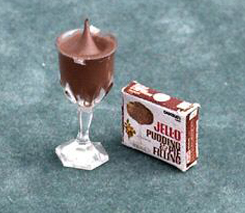Pudding
Pudding[edit | edit source]
Pudding is a type of food that can be either a dessert or a savory dish. The term "pudding" has different meanings in different parts of the world, and its preparation and ingredients can vary widely.
Types of Pudding[edit | edit source]
Puddings can be broadly categorized into two main types: sweet and savory.
Sweet Puddings[edit | edit source]
Sweet puddings are typically served as desserts and are made with ingredients such as milk, sugar, and flavorings. They are often thickened with starches like cornstarch or gelatin.
- Chocolate pudding: A popular dessert made with cocoa powder, sugar, milk, and a thickening agent. It is smooth and creamy, often served chilled.
- Blancmange: A sweet dessert made with milk or cream and sugar, thickened with gelatin or cornstarch. It is often flavored with almonds or vanilla.
- Kheer: A traditional Indian dessert made by boiling milk and sugar with rice, and flavored with cardamom, raisins, saffron, and nuts.
- Christmas pudding: A rich, steamed pudding traditionally served during the Christmas season in the United Kingdom. It is made with dried fruits, suet, and spices, and often soaked in brandy.
- Pudding with raspberries and whipped cream: A simple dessert pudding topped with fresh raspberries and whipped cream, offering a balance of tart and sweet flavors.
Savory Puddings[edit | edit source]
Savory puddings are often served as part of a main course and can include ingredients such as meat, vegetables, and grains.
- Haggis: A traditional Scottish dish made from sheep's offal mixed with oatmeal, suet, and spices, encased in the animal's stomach and boiled.
- Yorkshire pudding: A baked pudding made from a batter of eggs, flour, and milk or water. It is typically served as a side dish with roast beef and gravy.
Preparation Methods[edit | edit source]
Puddings can be prepared using various methods, including boiling, steaming, baking, and chilling. The choice of method often depends on the type of pudding being made.
- Boiling: Common for traditional British puddings like Christmas pudding, where the mixture is placed in a basin and boiled for several hours.
- Steaming: Used for puddings that require a moist cooking environment, such as suet puddings.
- Baking: Used for puddings like Yorkshire pudding, which require a high heat to rise and become fluffy.
- Chilling: Used for desserts like chocolate pudding, which are cooked on the stovetop and then chilled to set.
Cultural Significance[edit | edit source]
Puddings hold cultural significance in many countries. In the United Kingdom, puddings are a staple of traditional cuisine, with variations served during holidays and special occasions. In the United States, pudding often refers to a sweet, creamy dessert, while in other parts of the world, the term may refer to savory dishes.
Related Pages[edit | edit source]
Search WikiMD
Ad.Tired of being Overweight? Try W8MD's physician weight loss program.
Semaglutide (Ozempic / Wegovy and Tirzepatide (Mounjaro / Zepbound) available.
Advertise on WikiMD
|
WikiMD's Wellness Encyclopedia |
| Let Food Be Thy Medicine Medicine Thy Food - Hippocrates |
Translate this page: - East Asian
中文,
日本,
한국어,
South Asian
हिन्दी,
தமிழ்,
తెలుగు,
Urdu,
ಕನ್ನಡ,
Southeast Asian
Indonesian,
Vietnamese,
Thai,
မြန်မာဘာသာ,
বাংলা
European
español,
Deutsch,
français,
Greek,
português do Brasil,
polski,
română,
русский,
Nederlands,
norsk,
svenska,
suomi,
Italian
Middle Eastern & African
عربى,
Turkish,
Persian,
Hebrew,
Afrikaans,
isiZulu,
Kiswahili,
Other
Bulgarian,
Hungarian,
Czech,
Swedish,
മലയാളം,
मराठी,
ਪੰਜਾਬੀ,
ગુજરાતી,
Portuguese,
Ukrainian
Medical Disclaimer: WikiMD is not a substitute for professional medical advice. The information on WikiMD is provided as an information resource only, may be incorrect, outdated or misleading, and is not to be used or relied on for any diagnostic or treatment purposes. Please consult your health care provider before making any healthcare decisions or for guidance about a specific medical condition. WikiMD expressly disclaims responsibility, and shall have no liability, for any damages, loss, injury, or liability whatsoever suffered as a result of your reliance on the information contained in this site. By visiting this site you agree to the foregoing terms and conditions, which may from time to time be changed or supplemented by WikiMD. If you do not agree to the foregoing terms and conditions, you should not enter or use this site. See full disclaimer.
Credits:Most images are courtesy of Wikimedia commons, and templates, categories Wikipedia, licensed under CC BY SA or similar.
Contributors: Prab R. Tumpati, MD






